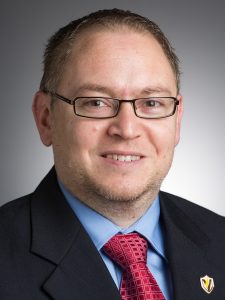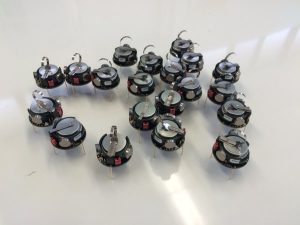Frederick F. Jenny Professorship of Emerging Technologies Sponsors Swarm Robotics Research at Valparaiso University

Sami Khorbotly, Ph.D., associate professor of electrical and computer engineering, currently leads research focused on finding optimized solutions through the use of robotic swarms. During the 2013-2014 academic year, Professor Khorbotly was awarded the Frederick F. Jenny Professorship of Emerging Technologies.
The Frederick F. Jenny Professorship of Emerging Technology, established by Catherine Jenny in honor of Frederick F. Jenny, is an endowed rotating position that provides funding and teaching relief to a College of Engineering faculty member in order to advance student knowledge in innovative fields. This professorship provided the necessary funding to purchase robots and equipment to build the swarms and afforded Professor Khorbotly the time needed to jump start the research effort.
“Being the Jenny professor for the past two years has been extremely important to my goal of expanding robotics education and research activity in the College of Engineering,” Professor Khorbotly says. “The established robotic swarm lab allows students to learn about robotic swarms and pursue undergraduate scholarship in that field and attracts prospective students interested in the field.”
 For the past two years, nine students have been afforded the opportunity to work on a variety of projects involving robotic swarms. One project uses the ant colony optimization algorithm to find the shortest path between an origin and a destination. This research has broad societal implications in its application to disaster zone evacuation efforts.
For the past two years, nine students have been afforded the opportunity to work on a variety of projects involving robotic swarms. One project uses the ant colony optimization algorithm to find the shortest path between an origin and a destination. This research has broad societal implications in its application to disaster zone evacuation efforts.
The robotic swarms are also being used by Professor Khorbotly in collaboration with Georges El-Howayek, Ph.D., assistant professor of electrical and computer engineering, in a project combining the particle swarm optimization and the spanning tree algorithms. This experiment utilizes the robotic swarms to navigate a search space looking for the optimal location, otherwise referred to as the hottest spot.
In a more light-hearted venture, the research team combined art and technology to create a robotic dance team to perform during half-time in support of the robotic football team. The robotic dance team debuted this April at the University of Notre Dame.
Several Valpo students have gained hands-on experience through this research, allowing them to delve deep into an area of particular interest while being mentored by Valpo faculty. The research has already resulted in the presentation of one conference paper; two more have been submitted for presentation and another two are currently being prepared.
